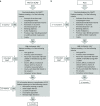Optimal duration of dual antiplatelet therapy for coronary artery disease
- PMID: 29713989
- PMCID: PMC5968000
- DOI: 10.1007/s12471-018-1113-5
Optimal duration of dual antiplatelet therapy for coronary artery disease
Abstract
The optimal duration of dual antiplatelet therapy (DAPT) for stable coronary artery disease and acute coronary syndrome is a complex decision. We review current literature on standard duration DAPT versus short duration DAPT (6 months or shorter) or extended duration DAPT (>12 months) after percutaneous coronary intervention with drug-eluting stent placement, and prolonged treatment after 12 months in acute coronary syndrome. Current guideline recommendations are summarised, including the use of risk scores for ischaemic and bleeding risk assessment. Because of the limitations of current risk scores, we propose multiple patient-related and procedure-related factors for the ischaemic and bleeding risk assessment aiding in personalised DAPT duration.
Keywords: DAPT; Long-term; Short-term.
Conflict of interest statement
W.J. Kikkert reports receiving speaker fees from Astra Zeneca and P. Damman reports receiving a research grant from AstraZeneca.
Figures


References
-
- Population Division. Department of Economic and Social Affairs. United Nations. Revision of World Population Prospects. https://esa.un.org/unpd/wpp/. Accessed 13.10.2017
-
- Dangas GD, Serruys PW, Kereiakes DJ, et al. Meta-analysis of everolimus-eluting versus paclitaxel-eluting stents in coronary artery disease: final 3‑year results of the SPIRIT clinical trials program (Clinical Evaluation of the Xience V Everolimus Eluting Coronary Stent System in the Treatment of Patients With De Novo Native Coronary Artery Lesions) JACC Cardiovasc. Interv. 2013;6:914–922. doi: 10.1016/j.jcin.2013.05.005. - DOI - PubMed
Publication types
LinkOut - more resources
Full Text Sources
Other Literature Sources

